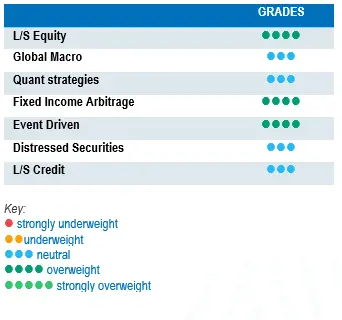 Like the Rolling Stones during a concert, the dovish stance from the Fed had the effect to “spread out the oil, the gasoline”[2] on a market that was already anticipating a brighter future. This came as a surprise, as, a few weeks ago, faced with a roaring market, Jerome Powell reiterated the message of higher rates for longer. Although the market was very quick to reprice a more supportive market environment through rate cuts, investors are still divided regarding market expectations for 2024.
Like the Rolling Stones during a concert, the dovish stance from the Fed had the effect to “spread out the oil, the gasoline”[2] on a market that was already anticipating a brighter future. This came as a surprise, as, a few weeks ago, faced with a roaring market, Jerome Powell reiterated the message of higher rates for longer. Although the market was very quick to reprice a more supportive market environment through rate cuts, investors are still divided regarding market expectations for 2024.
Equity markets continued their positive run into the last month of the year, returning positive mid-to-high single-digit returns. Biotechnology and small and mid-sized companies in the US benefited the most from the expected rate cuts. European equities followed in sympathy, although economic expectations for the region are modest. At sector level, cyclicals outperformed.
Easing inflation expectations had a greater impact on US and UK sovereign yields. Mid- to long-term US maturity yields have eased between 60 to 100 bps over the last two months, while falling by around 50 bps for the 5-year gilt.
The HFRX Global Hedge Fund EUR returned: 1.2% over the month.
Long-Short Equity
Overall, Long-Short Equity generated positive returns over the month, benefitting from the equity rally into year-end. However, short stocks’ alpha generation was negative, mostly due to position covering. Although the average Global Long-Short Equity fund has generated mid-single-digit positive returns since the start of the year, alpha generation has been inconsistent throughout the period. During the first half of the year, market breadth was narrow, with performance driven by a very limited number of stocks and thematics. The situation improved during the last two quarters, but this contributed to a below-average upside capture ratio of equity benchmarks by Long-Short Equity managers. According to data from Morgan Stanley Prime Brokerage, the average performance of Global Long-Short Equity funds captured 36% of world equity indices. From a regional perspective, relative performance ratios for the year were very similar for funds investing in the US, Europe or Asia. In absolute terms, strategies focused on the US outperformed their peers in Europe and Asia. A mix of beta tailwind and positive stock selection helped enable Long-Short Equity strategies end the year among the top performing strategies. Now that the rate hiking cycle is reaching the end of its course, we expect higher dispersion inter and intra sectors, which will be beneficial for Long-Short Equity strategies. Furthermore, these strategies have more tools than traditional long only strategies to help navigate market volatility, should the consensus scenario of moderate growth for 2024 hit a road bump.
Global Macro
Average performances for Global Macro strategies during the month were positive but modest. Although market moves in interest rates and equities were very significant, a large number of managers were running lower than average risk exposure due to higher levels of uncertainty levels. Many also favoured relative value implementations over straight directional bets. Managers adopting a glass half full view of the economy performed best over the month, making money on long equity and fixed income positions. The full-year performance was relatively dispersed depending on the manager’s risk appetite and confidence that inflation indicators would weaken. Returns generated by macro strategies since the start of the year were relatively muted and below expectations. However, the current and foreseeable environment is expected to offer interesting investment opportunities.
Quant strategies
Trend-following strategies on average performed well over the month, benefiting from positive contributions from their short- and medium-term models. Long positions in equities and fixed income were the main performance drivers. Statistical arbitrage strategies tended to lose money during the month, as they were negatively impacted by the rally on lower quality companies, which they tend to be short of. Performance across Multi-Strategy Quantitative funds was dispersed. Since the start of the year, Multi-Strategy Quantitative strategies were more resilient than CTAs in balancing negative contributions from trend models with positive contributions from non-directional arbitrage models.
Fixed Income Arbitrage
2023 will undoubtedly be a year to remember for the fixed income market, which can be succinctly summarised in a few words: the need for speed. From January to mid-October, with the exception of the SVB quick reversal in March, central banks globally hiked interest rates at one of the fastest paces in market history. This move triggered the repricing of the entire bond market spectrum and marked the end of an incredible era of zero-rate policy. As 10-year US Treasuries reached the 5% mark, the entire bond market experienced its most intense reversal in the history of the interest rate market. Strategies that combined pure price arbitrage with fundamental relative value positions were able to capitalise on the volatility as market flows completely reversed. Simultaneously, directional managers were successful in withstanding the reversal, taking profits and significantly reducing their risk. As we enter a new chapter of potentially lower rates, an outcome few could have imagined just two months ago, the strategy is poised to benefit from increased volatility.
Risk arbitrage – Event-driven
It was a strong month for Event Driven managers. Overall, the various sub-strategies contributed positively to performance. Merger arbitrage benefitted from the successful completion of the acquisition of Seagen by Pfizer and from expectations that the rate hike cycle is at an end, which should give boost the number of deals announced in 2024. Special situation strategies in equities and credit have benefitted from the risk-on environment, since these strategies have a longer net exposure and lower quality securities, which benefit from higher risk appetite levels. Merger announcements have been relatively muted for the last two years, which is understandable in the context of market volatility. According to strategy specialists, the number of deals announced is more correlated to the level of visibility corporate management has on the state and direction of the economy rather than the level of the cost of debt itself. As inflation slowly trickles down and interest rates near their peak, we might be at the beginning of a nice cycle for the strategy.
Distressed
Over the last 18 months, expectations for distressed opportunities have evolved significantly. Coming into the end of 2022, the red hot inflation levels and rapid rate hike cycle were indicators of a distressed cycle bonanza not seen since the Great Financial Crisis. These expectations dwindled during 2023, as the economy and job market remained resilient. The opportunity set during the year was opportunistic in nature, taking advantage of specific events such as the banking crisis in the US during the first quarter of 2023 or from idiosyncratic situations. Currently, default levels have started to increase, although expectations remain contained considering most corporations opportunistically refinanced their outstanding debt at lower rates in 2020-2021 and that consumers’ financial health remains relatively strong. While strategy specialists remain largely on the sidelines focusing on idiosyncratic opportunities, they remain cautious about investing in high-yield issuers and have identified cracks in specific areas such as the loan market. Some market participants have taken on large debt loads through loans, which are usually floating-rate issues, without anticipating such a meteoric rise in short-term rates.
Long short credit
The appeal of Long-Short credit strategies seems to be improving. An environment of higher rates for longer could be a tailwind for alpha generation both on long and short positions, as fundamental research becomes more important in portfolio construction. Absolute return or hedged investment approaches have gained more relevance as positions in AT1 issues have generated significant volatility and market losses for the investment community. Yields have widened, again giving fixed income a seat at the asset allocation table. However, as recent events have demonstrated, risk diversification is very important and should be an integral part of the investment allocation process.
[1] Start me up” by the Rolling Stones
[2] Extract from the lyrics of “Start me up” by the Rolling Stones
